ITF Southeast Asia Transport Outlook
This report provides scenarios for future transport demand and CO2 emissions in Southeast Asia up to 2050 to help decision-makers chart pathways to sustainable, resilient transport. The scenarios reflect existing policy initiatives and specific constraints in the region. They also examine the potential impact of policies addressing the challenges and opportunities for transport from Covid-19.
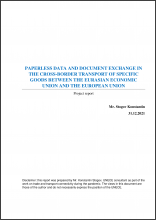
Paperless Data and Document Exchange in the Cross-Border Transport of Specific Goods between the Eurasian Economic Union and the European Union
In the context of the recovery from the COVID-19 pandemic and the general direction of building back better this project aims to develop and practically test paperless data and document exchange in the cross-border transport of specific goods between the Eurasian Economic Union and the European Union.
Focusing on a specific pilot case of multimodal delivery of goods author of this study conducted research and offered practical recommendations how to align used by different participants in the supply chain in their IT systems to the UN/CEFACT standards and Multimodal Transport Reference Data Model, allowing for a seamless exchange of electronic data and documents (B2B exchange), as well as developing electronic B2G documents for submission to regulatory authorities.
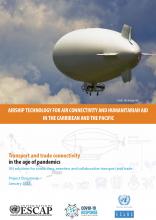
Airship Technology for Air Connectivity and Humanitarian and the Caribbean and the Pacific
The Airship transport alternative, in its diverse engineering variants, has the potential to be a game-changing technology with significant development in recent years. It offers the technical capabilities to make a broad contribution to the optimization of mobility and logistics networks in isolated communities and territories, especially but not only in Small Island Developing States (SIDS). This is particularly important in the context of the ongoing COVID-19 pandemic, as in the event of a disaster, different aid agencies are deployed with support in the distribution and logistics of perishable and essential cargo, equipment, and assistance personnel. This innovative mode should be incorporated into the transport matrix (both nationally and regionally), for the latter to move towards more efficient, sustainable, and resilient networks.
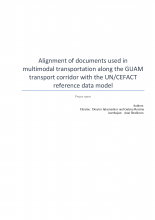
Alignment of documents used in multimodal transportation along the GUAM transport corridor with the UN/CEFACT reference data model
The objective of this project is further development of the digital transport documents that could provide seamless information flows accompanying cargo flows between countries along the GUAM transport corridor. Due to its position in the middle of the cargo transport routes between Europe and Asia, the use of UN/CEFACT standards and recommendations for cargo information sharing along this route makes much sense.
The focus of the project is on the practical application of the data models and standards to facilitate real-world transport operations that take place along this transport route. This is achieved by creating digital twins of real business documents that are mapped to the UN/CEFACT multimodal transport reference data model (MMT RDM) to ensure interoperability both in terms of changing jurisdictions and modes of transport along the route.
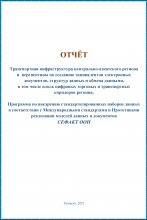
CA Transport Infrastructure and Perspectives on Development of Electronic Document Equivalents, Data Structures and Data Exchange
This Report serves as a preparation to the research of trade and transport corridors going though the Central Asia and establishes the necessity of digitalization of multimodal transport data as well as exchange of documents along those corridors through the use of UN & UN/CEFACT standards.
This Project is the joint initiative of the UNECE and the Ministry of Transport of the Republic of Uzbekistan.
The relevance of this project is the current common interest of all the countries in the region to jointly develop the transport links.

COVID-19 and maritime transport: Disruption and resilience in Asia
Impacts of The presentation sets out the impact of the COVID-19 disruption on maritime trade flows, port calls, and liner shipping connectivity in Asia. It also considers the response measures and coping strategies adopted in the face of the disruptive pandemic, and the lessons learned and good practices relating to the maritime supply chain resilience-building.the COVID-19 disruption on maritime trade flows, port calls, and liner shipping connectivity in Asia
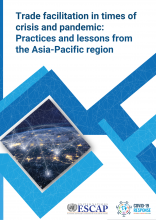
Trade facilitation in times of pandemic: practices and lessons from the Asia-Pacific region
The Coronavirus 2019 (COVID-19) pandemic has hit international trade worldwide and in Asia and the Pacific, underscoring the importance of maintaining trade connectivity not only for the immediate pandemic response, but also for the subsequent recovery efforts in order to build resilience to future disruptions. The report first describes, in the section II, the initial developments and lessons learnt in trade and transport facilitation practices in response to the COVID-19 pandemic. Section III presents the results of a Survey on trade facilitation in times of crisis and pandemic in the Asia and the Pacific region. Finally, Section IV discusses the ways forward for trade facilitation measures to support a sustainable and resilient recovery from the COVID-19 crisis and how the Asia-Pacific region can be better equipped to build back better.
Trade Facilitation - Crisis response package
UNCTAD Trade Facilitation Section has developed a Crisis Response Package which aims to assist countries to mitigate socio-economic impacts during periods of crisis.

Seamless and smart connectivity along the Asian Highway network in the time of COVID-19
This technical note aims to offer policy recommendations for policy responses using new technologies and smart road solutions to preserve the regional transport connectivity in the time of the pandemics and other similar disruptions.